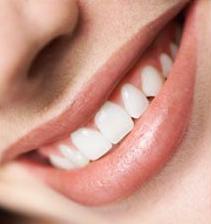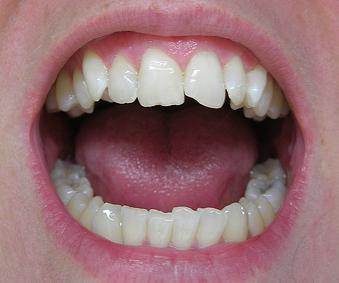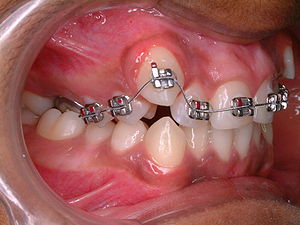
Straight teeth
Most of us are not blessed with perfectly aligned straight teeth and sometimes we can become very conscious as to how our teeth look when we smile. Besides being aesthetically unappealing, some people find it hard to chew certain food with crooked teeth. and are unable to clean their teeth properly leading  to problems such as gingivities and caries. If you answered yes to any of these two problems, chances are that you will benefit from tooth straightening. Adult teeth straightening is quickly gaining its place in dentistry as more adults turned to dental professionals to achieve straighter teeth.
What causes crooked teeth?

Crooked teeth, Image from dairycow2
Before jumping into tooth straightening, we first have to look at what may have caused crooked teeth. While there is a strong hereditary influence, diseases and environmental factors can also lead to crooked teeth. Systemic or local diseases such as caries may cause changes to the developing dentition in children, causing disruption to tooth eruption. Seemingly harmless habits such as finger or object sucking, lip or nail biting and tongue thrusting can often place enough pressure to move teeth, causing them to be crooked.
Tooth straightening of crooked teeth
Ever wonder why some people have such perfect straight teeth? It is highly likely that they’ve had tooth straightening treatment because as it turns out, malocclusion, which is a term used to describe misaligned or crooked teeth, is universal. So if we were to get technical, almost everyone will have some form of malocclusion. In this advanced world of dentistry, there are a variety of teeth straightening options available to us, such as orthodontic braces, teeth veneers, teeth crowns and teeth straightening surgery. Orthodontic braces or dental braces by far, remained the most popular choice of tooth straightening.
Tooth straightening methods

Orthodontic braces
Tooth straightening with orthodontic braces are conducted under the supervision of a qualified orthodontist. It involves the placement of a small bracket on each tooth which are then linked or tied together with a wire. The brackets are usually placed on the front surface of teeth. There are times when the brackets are placed on the inside surfaces of teeth, mostly for aesthetic purpose, commonly referred to as lingual braces. Orthodontic braces is the most conservative option of tooth straightening with the downside of treatment usually taking 18-24 months to complete. A further retention period after the removal of braces is also required to maintain the straightened teeth. Good orthodontic braces care and strict tooth brushing practices are essential to ensure success of treatment.
Teeth veneers and teeth crowns are the quickest options to straightening teeth, as popularly seen on the Extreme Makeover shows. Teeth veneers are made entirely from porcelain or ceramic. Teeth crowns can be constructed either fully in metal or in porcelain, or partially in porcelain that is laminated on a metal or zirconia structure. Strictly speaking, this option does not straighten the tooth (crown and root); rather it masks the portion of the crown that is visible in the mouth, making it to appear straight. This can be achieved by cutting or trimming back crooked teeth, allowing veneers or crowns with the correct shape and alignment to be placed over them, creating straight teeth. Treatment can be arranged with your dentist and often takes roughly 2 weeks to complete. This method of tooth straightening may not be beneficial, depending on the severity and number of crooked teeth involved as it can be very destructive due to the amount tooth structure removed.
Prior to jaw surgery
Teeth straightening surgery, or technically known as orthognathic surgery is often carried out in conjunction with orthodontic braces on patients with severe skeletal deficiencies when the latter alone is inadequate in straightening teeth. Examples of such deficiency include cleft palate and jaw discrepancies. This type of teeth straightening surgery can only be performed by oral maxillofacial surgeons under general anaesthesia and is the most invasive of all options. Treatment period is also very lengthy as it is paired with orthodontic braces for pre-surgical preparation and post-surgical maintenance.
Teeth Straightening Costs
Tooth straightening are generally not cheap, with most coming at a hefty price tag. Teeth straightening costs can vary a lot, depending on the procedure chosen. Orthodontic braces generally cost from 3500 to 7000 dollars depending on the type of braces chosen. The price of teeth veneers varies from 1000 to 2000 dollars depending on the country and state you live in. Teeth crowns cost around 600 to 3000 dollars, the large variation being attributed to the type of material used to fabricate the crowns, with metal crowns such as gold costing the least, to porcelain bonded to metal crowns and full porcelain crowns costing the most. Teeth straightening surgery is the most expensive option of all and the price varies depending on the specific reconstruction needed, ranging from 10,000 up to 35,000 dollars and sometimes more.
Which teeth straightening option is the best for me?
Unfortunately, there is no fixed answer for that as tooth straightening is not ‘one size fits all’. Each individual case will need to be carefully assessed by a dentist with the benefits and risks of each tooth straightening option being considered by you and your dentist before making the final decision.
Pingback: Orthodontics article « s0hp0h (。◕‿◕。)
This is a good discussion of options for orthodontic treatment. Whatever kind you decide on, it’s really important afterwards to wear your retainer at night forever. It’s a no-brainer, so easy, and keeps the look of the new smile. I had to get adult braces again last year to close up a gap that opened between my lower front teeth, because when I had my teen braces back in the 70s, it wasn’t understood that teeth just keep moving through adulthood. My teeth now look great, and I’m sold on the retainer!
Pingback: 3 Types of Orthodontic Braces You Must Know About | Intelligent Dental
Pingback: More dental related stuff « s0hp0h (。◕‿◕。)
Pingback: Tooth straightening with invisible braces | Intelligent Dental
Pingback: Top tips to care for adult orthodontic braces | Intelligent Dental
Pingback: Toothbrushes for Braces and Orthodontics | Intelligent Dental
Pingback: What Dental Corrective Surgery Could Do For You Part 1 | Intelligent Dental
Pingback: All about tooth sensitivity: Part 1 | Intelligent Dental
Pingback: After orthodontic braces treatment: not the end | Intelligent Dental